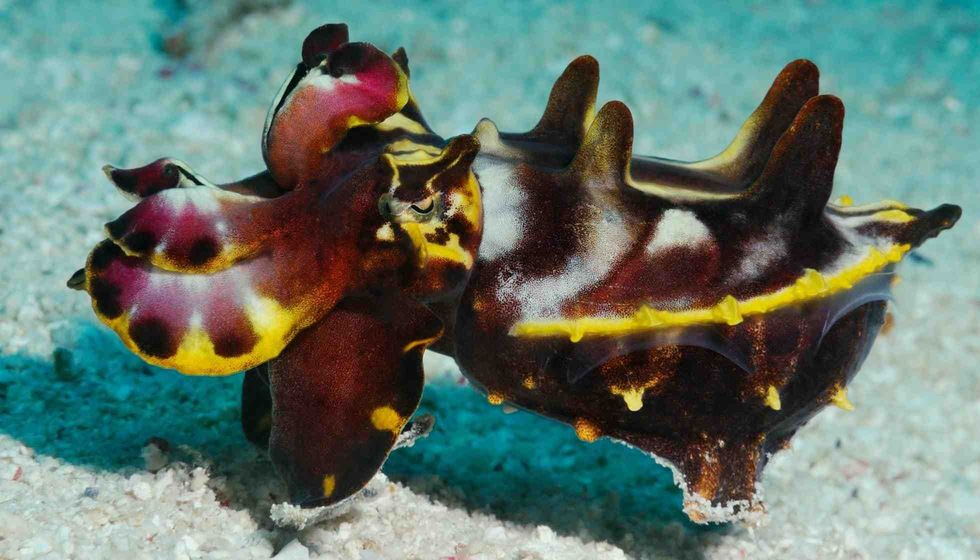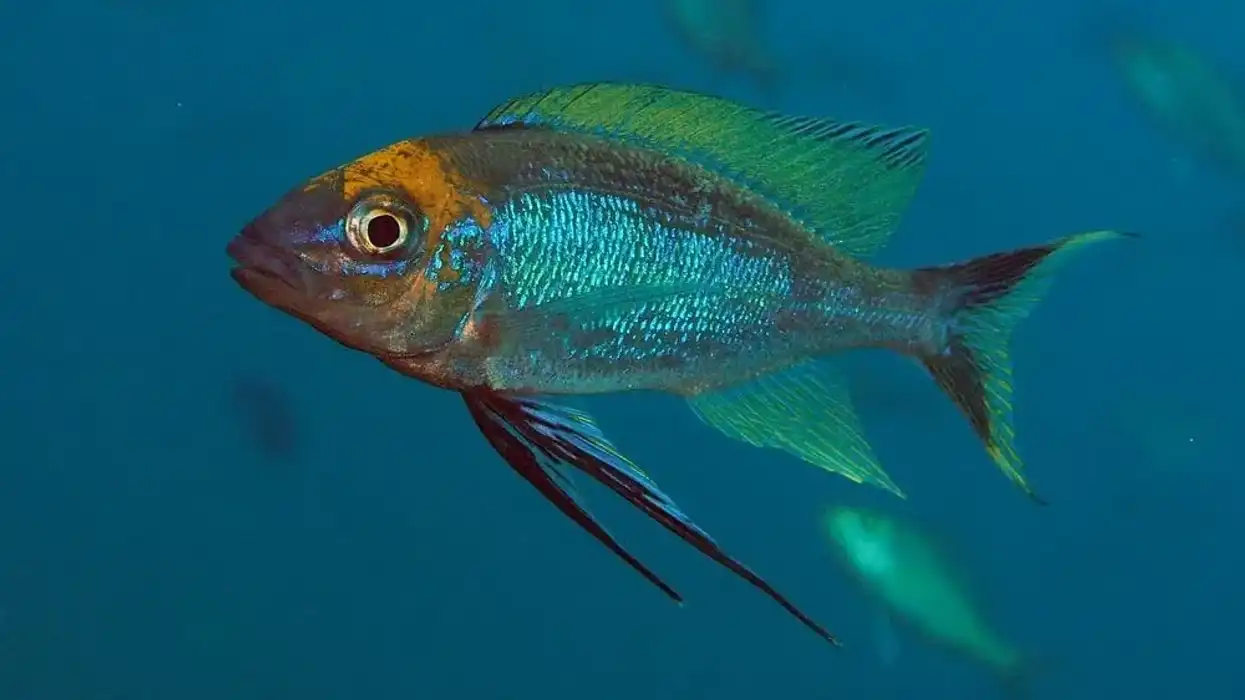Cuttlefish, or cuttles, are marine mollusks in the Sepiida order. The flamboyant cuttlefish (Metasepia pfefferi) inhabits the Indo-Pacific waters around Australia, New Guinea, along with various islands of the Philippines, Indonesia, and Malaysia.
Flamboyant cuttlefish size can extend up to 3 in (8 cm) and the flamboyant cuttlefish eggs are laid one by one by the female and attach to the roof of the cave.
Flamboyant cuttlefish walking along the seafloor as compared to swimming is an uncommon feature amongst aquatic animals. The meat of this vivid cephalopod contains unusual acids, rendering it unfit for human consumption.
The base color of this species is dark brown with overlapping patterns of white and yellow. Here are a few interesting facts on flamboyant cuttlefish (Metasepia pfefferi). However, if you are interested in browsing through some more fish, you must check out the paddlefish and the rockfish.
Flamboyant Cuttlefish Interesting Facts
What type of animal is flamboyant cuttlefish?
Flamboyant cuttlefish (Metasepia pfefferi) is a type of cuttlefish that is of the family Sepiidae. Cuttlefish have a really short lifespan of only a year whereby females die just after spawning.
What class of animal do flamboyant cuttlefish belong to?
Flamboyant cuttlefish belong to the fish class of animals that can be found in the Indo-Pacific waters around Australia, New Guinea, the Philippines, Indonesia, and Malaysia.
How many flamboyant cuttlefish are there in the world?
There is no estimation of how many flamboyant cuttlefish are left in the world.
Where do flamboyant cuttlefish live?
Flamboyant cuttlefish like to live in tropical waters on sandy and muddy substrates.
What is a flamboyant cuttlefish's habitat?
Metasepia pfefferi is a bottom dweller that can be found at depths ranging from 10-300 ft (3-91 m). These venomous cephalopods prefer tropical waters of the Indo-Pacific for their habitat.
Who do flamboyant cuttlefish live with?
Flamboyant cuttlefish lives alone for most of their life. These cephalopods live with their partners during the mating season.
How long do flamboyant cuttlefish live?
Based on information of other species in the same genus, the lifetime of flamboyant cuttlefish is expected to be between 18-24 months. However, several females die after spawning. Since Metasepia pfefferi is rarely kept in captivity, its life cycle in captivity has not been recorded.
How do they reproduce?
Internal fertilization is used by these cephalopods to reproduce. Females almost often mate with more than one male.
They start to actively mate at around five months of age. To clean out spermatophores from the previous mating, male cuttlefish can spray water into the female's buccal region.
The males locate a sheltered cave and await an interested female.
The breeding ritual involves waves wherein the males rapidly wave three pairs of arms to attract the female for breeding while the female remains camouflaged and do not exhibit any mating behavior. Once, the mate has been found, both the male and female will enter the cave and start the reproduction process.
The males make use of a special appendage for fertilizing the females by placing spermatophores inside a pouch under the female's mantle. The female lays her eggs one by one when camouflaged and attaches the eggs to the roof of the den and then dies shortly after giving birth during the reproduction season.
What is their conservation status?
There has been little or no study into the conservation status of this cephalopod species. As a result, the conservation of these colorful cephalopods' status could not be determined due to a lack of data. Plenty of these fishes can be found in a private aquarium or a tank across the world.
Flamboyant Cuttlefish Fun Facts
What do flamboyant cuttlefish look like?

Flamboyant cuttlefish are a large-looking species with a long, oval mantle. The arms are long and bladelike, with four rows of suckers.
The hectocotylus, a shortened arm used by males for fertilization, is carried on the left ventral arm. The changing area of the hectocotylus has a large, swollen, and fleshy oral surface. It has transversely grooved ridges and a deep furrow down the middle.
The tentacular clubs' sucker-bearing surface is flattened, with five or six suckers grouped in transverse bands. Dorsal and ventral membranes vary in length and extend along the stalk near the carpus. At the junction with the stalk, the dorsal membrane forms a shallow cleft.
The flamboyant cuttlefish can change the color of the skin, thanks to the special pigment cells called chromatophores. The chromatophores are present under the layer of the skin and provide the aquatic animal with the ability to camouflage.
How cute are they?
Flamboyant cuttlefish look cute in general but when they rarely display their vibrant colors which are more appealing and beautiful to look at.
How do they communicate?
Flamboyant cuttlefish have well-developed eyes that can sense polarised light, but they are most definitely colorblind. The eye can be reshaped to reflect on individual items. Males can put on displays to attract females. Some flamboyant cuttlefish can navigate mazes using only visual cues. They have the ability to sense sound waves.
How big is a flamboyant cuttlefish?
A flamboyant cuttlefish is eight times bigger than the world’s smallest fish, paedocypris progenetica. The flamboyant cuttlefish size range is 2-3 in (6-8 cm).
How fast can a flamboyant cuttlefish swim?
A cuttlefish can also hover or swim slowly by undulating its fins over its body's sides. Since their cuttlebone is too weak for them to swim for long, these sluggish swimmers walk around the seafloor with their arms.
How much does a flamboyant cuttlefish weigh?
A flamboyant cuttlefish weight can extend up to 0.8 lb (0.36 kg). The weight of this sea creature might be slightly higher when kept in an aquarium.
What are the male and female names of the species?
There is no specific name for a male and female species of this venomous cephalopod, they are simply known as males and females. These colorful cephalopods are identified by their size. Male flamboyant cuttlefish are significantly smaller than females.
What would you call a baby flamboyant cuttlefish?
There is no specific and exact name for a baby flamboyant cuttlefish, they are simply called juvenile flamboyant cuttlefish.
Do humans eat them?
No, flamboyant cuttlefish are technically toxic because their poisons are not injected into a bite or sting. Hence, these wild cephalopods can not be consumed by humans.
Are they dangerous?
The flamboyant cuttlefish is unique as it is the only cuttlefish that is toxic (if eaten) and one of the only three known venomous cephalopod species. While cuttlefish occasionally come into contact with humans, their poison is highly toxic and can be as lethal as the poison of a blue-ringed octopus.
Hence, these cephalopods must be left in their natural environment to thrive in the wild.
Would they make a good pet?
Researchers consider the flamboyant cuttlefish to be the perfect invertebrates, but flamboyant cuttlefish pets have very unique requirements. These wild cephalopods require proper care and management in the aquarium from a professional. For the majority of people, they are not suitable pets.
There are eight broad arms with suckers and two tentacles with flattened tips around the mouth. Both of these are used to attract the prey as well as catch the prey.
Did you know...
In comparison to other cephalopods, such as a colossal squid, Metasepia pfefferi is a sluggish swimmer due to its small cuttlebone.
These sea creatures can change color in response to their surroundings, either to attract prey or to deter predators.
The flamboyant cuttlefish price starts from around $120 and can extend up to $195.
At what age do flamboyant cuttlefish reproduce?
Around five months of age, male flamboyant cuttlefish begin to actively mate to reproduce by attracting the female flamboyant cuttlefish inside its cave.
What type of defenses do flamboyant cuttlefish have?
Camouflage is the predominant mode of protection for both male and female Metasepia pfefferi, and these sea animals remain camouflaged nearly all of the time.
Here at Kidadl, we have carefully created lots of interesting family-friendly animal facts for everyone to discover! Learn more about some other fish from our white tuna facts and warmouth facts pages.
You can even occupy yourself at home by coloring in one of our Flamboyant Cuttlefish coloring pages.










